Developments at the Rector Gabriel Ferraté Library, UPC
The purpose of this paper is to highlight the mobile services developed by the Rector Gabriel Ferraté Library (BRGF) of the Universitat Politècnica de Catalunya (UPC-Barcelona Tech) in Barcelona, Spain.
We hope this paper will be of use to other libraries exploring new technologies for communicating and delivering their services to users at a time when mobile services are an emerging topic in librarianship and information science literature. By setting out the successive steps involved in the as yet unfinished process of building our mobile services portfolio, we aim to offer a detailed picture of the mobile services and features offered by a university library from a case study perspective.
The main topics to be discussed include:
-
The BRGF’s mobile website, including the information available, its interactive capabilities and the services it provides to its users.
-
The mobile-friendly version of UPCommons (the UPC Library Service’s institutional repositories).
-
The UPC Library Service’s mobile OPAC.
-
The mobile version of u-win (BRGF’s videogame service).
-
The use of QR codes to deliver information to mobile devices.
-
Text message notifications.
Additional topics for discussion include:
-
The library’s organisation and the organisational concepts that underpin and make possible its technological developments (including mobile).
-
BRGF’s concern regarding the reduction of investment in the development of mobile services.
-
The criteria and tools used to guide the library’s decisions regarding the design and orientation of current and future mobile services.
-
How mobile services can help to improve the image of the library as a leading technology site.
-
Selected mobile features that BRGF plans to offer in the near future.
Ultimately, this paper aims to delineate the effectiveness and potential of delivering library services by the preferred means of communication of a new generation of students and teachers.
The Rector Gabriel Ferraté Library (BRGF)[1] is located on the North Campus of the Universitat Politècnica de Catalunya (UPC-Barcelona Tech)[2] in Barcelona. The BRGF is part of the UPC’s Library and Documentation Service (SBDUPC) and the largest library at the UPC,[3] accounting for approximately 25% of the total volume of the university’s library system.
The BRGF offers direct services to nearly 8,000 students and faculty members from the Barcelona School of Informatics (FIB),[4] the Barcelona School of Telecommunications Engineering (ETSETB),[5] the Barcelona School of Civil Engineering (ETSECCPB),[6] 22 research departments and their administrative staff and services, and many of the university’s general services (Human Resources Service, Language and Terminology Service, International Relations Service, Accounts and Finance Service, etc.).
The disciplines taught on UPC’s North Campus foster highly technological environment in which students and faculty members are not only quite skilled in the use of information and communication technology (ICT), but also use it regularly in both their academic and personal lives. It is a place where the latest proposals and innovations in the sector to come on the market quickly find users and consumers.
In this environment, the BRGF is emphasising the use of new technologies and digital tools to carry out new projects and improve existing services. This push is in keeping with its commitment to working on innovative services and projects that both cater for the needs of students and faculty members and help to make technology the library’s hallmark.
From this perspective, the UPC libraries believe that mobile applications which not only facilitate access to information resources from anywhere and by means of any mobile device, but also take advantage of the capacity of these devices to offer users access to library services, will be (indeed, already are) critical to bringing our products and services closer to users.
In short, we are convinced that accompanying users at all times by means of their mobile phones will soon be more of a necessity than an option. Consequently, one of our technological priorities is to develop the necessary services. To this end, BRGF decided some time ago to offer a series of mobile applications, even though the time was not yet entirely ripe for immediate success. In the current highly competitive informational context, BRGF believed that the greatest risk was to take no risks at all.
This paper includes the following:
-
Some reflections on the technological context of academic libraries.
-
The main reasons why BRGF and SBDUPC chose to develop the aforementioned applications and an explanation of how they were ultimately developed.
-
A list and brief description of the main mobile services developed by BRGF and SBDUPC.
-
Proposals for future mobile services at BRGF and SBDUPC.
We hope that sharing our experience will contribute to raising awareness among academic libraries of the new possibilities for developing mobile services in their respective environments and encourage librarians to approach users in a way that allows them to meet student and faculty service needs more effectively.
It is clear at a glance that mobile services are a fully integrated part of university students’ lives. Mobile technologies, and especially mobile phones, are part of their everyday gear, and mobile phones are the electronic device of choice for today’s mobile generation (see data from Ofcom, 2011 below).
More generally, at this point, few would debate the pre-eminent position held by mobile devices in technologically advanced societies. Their ubiquity notwithstanding, we believe it is worth offering some data, primarily from Spain and Europe, that may help to quantify the issue and contextualise the importance of taking these communication devices into account when designing and implementing library services:
-
In Spain, there are far more mobile telephone lines than inhabitants: specifically, as of January 2010, there were 52,810,480 lines, according to data published by the Spanish Telecommunications Market Commission (Comisión del Mercado de las Telecomunicaciones, 2010), but just 47,021,031 inhabitants, according to data from the Spanish National Institute of Statistics (Instituto Nacional de Estadística, 2010).
-
According to Nielsen (2010):
-
In Spain, 21% of young people between the ages of 15 and 24 use their mobile phones to access the Internet. In fact, this was the most popular mobile phone feature among all those examined in the report (the figure rises to 46% in the United Kingdom and stands at 24% in Italy and 20% in Germany).
-
Some 38% of mobile phones belonging to Spaniards between the ages of 15 and 24 are smartphones. This figure is 47% in Italy, 36% in the United Kingdom, and 29% in Germany.
-
Some 58% of Spaniards between the ages of 15 and 24 are advanced users, using their mobile phones for far more than just voice calls and text messages. This figure is 68% for the United Kingdom, 62% in Italy and 47% in Germany.
-
-
According to Ofcom (2011), in The Communications Market 2010 (August), using mobile phones is the media activity that Britons between the ages of 16 and 24 would miss the most, namely: 33% compared to 28% who would miss television the most and 21% who would miss the Internet the most. It hardly seems risky to venture that these figures will be similar for young Catalans.
-
Fundación Teléfonica (2010) also offers a series of figures worth bearing in mind when positioning Catalan and Spanish libraries with regard to mobile services:
-
Out of all homes with Internet connections, 25% connect by mobile phone and 13.8% by video-game console.
-
3 out of ever 10 Spanish citizens already own 3G-enabled devices, and 1 in 10 has a smartphone.
-
Smartphone sales across Spain increased by 90% last year.
-
The percentage of smartphone users who connect to the Internet is 15 times higher than that of feature-phone users.
-
Some 86% of Spanish citizens believe that using the Internet facilitates learning.
-
-
According to the Federation of Spanish Publisher Guilds (Federación de Gremios de Editores de España, 2010), 5.3% of the Spanish population already regularly reads e-books. Of this group, 6.9% use mobile devices other than e-readers to do so, while only 1% use e-readers.
It is worth noting that the UPC libraries are convinced that these figures are significantly higher among the university’s student body and faculty and that the expansion of mobile features into fields such as entertainment, administrative and business services and formalities, shopping, interpersonal communication, etc., together with the increasing implementation of technologies associated with mobile devices, such as Bluetooth, QR codes, global positioning systems or augmented reality, suggest that the trend towards growing use of and demand for mobile features will become even more dramatic in our environment.
As some of the above figures suggest, the growth of smartphones has been quite sudden; just a few short years ago, these types of telephones were not at all common among mobile phone consumers in Catalonia. However, since the first tactile devices appeared, smartphones have met with unmitigated success. The emergence of phones such as the iPhone or Android marked a before and after in mobile telephony and created a new market with its own business model based on online application shops (appmarkets) and a strong trend towards the development of software specifically suited for mobile devices, i.e. the aforementioned, and by now omni present, apps. These apps have met with unqualified success and are being used more and more intensively. So why did BRGF decide to develop a mobile website instead?
First, when we began to develop and offer our mobile services, in the first half of 2009, apps were hardly common place among our users. In fact, as we will continue to stress throughout this paper, even ordinary smartphones were not particularly widespread, let alone smartphones with tactile screens. It thus seemed too risky to base our initial offer on apps and simply hope that they would have at least a minimal impact on our users.
Second, we did not wish to be bound to a single platform. At present, for an application to be compatible with the main mobile phone operating systems — iOS, Android and Symbian — it must be manufactured three times, as each system has its own development environment. Given the UPC libraries’ limited resources, universal compatibility was thus unthinkable: to develop an app, we would have to have chosen a single platform, thereby excluding all users who used a different one. We believed that, even though it meant sacrificing some of the benefits of an app, by choosing to develop a mobile website instead, we would be able to reach more users, as all they would require was a mid- or high-end mobile with a browser and an Internet connection. Ultimately, we gave more importance to achieving maximum dissemination than to having the sleeker, more powerful type of interface possible with an app.
Third, the library already had staff members with ample experience in web design. This meant that developing a mobile website would entail virtually no learning costs, as they would only need to learn a few key differences between normal and mobile web design. In contrast, developing an app would have required training in and mastery of the development tools and platforms for the chosen system, with the ensuing commitments in terms of time and cost. Likewise, given that it would have meant working in a new development environment, it would surely have affected time it would take ultimately to roll out the service.
In other words, creating a service platform based on a mobile website had a very low cost in terms of time and resources and ensured a swift roll-out, both of which were obviously key factors leading to the choice for this option.[7]
In any event, although the UPC libraries remain committed to the website format as their primary option, above all because they consider it to be the best choice to maximise impact, the future development of a supplementary app for one or more of the main platforms on the market has not been ruled out, with a view to capitalising on the benefits that such a solution might offer for the current system.
One of the most widespread conclusions in the literature on mobile library websites is that they should not be merely a literal translation of the traditional website. Instead, they should be a simplified version offering content and services that have truly been adapted for mobile use.
BRGF’s mobile website was designed according to these criteria and is intended to be accessed by mid- to high-end mobile devices. BRGF decided to target these devices in order to offer a more attractive homepage than it could have, if it had catered to lower-end devices, which tend to allow only text and hyperlinks.
Other principles taken into account included:
-
In addition to offering information, the site had to include service request forms and enable interaction with end users.
-
All retrieved content had to be original; under no circumstances would replicas be allowed.
-
Access to content had to be real-time, never delayed.
-
The Smubtool would be used to ensure dissemination in social networks by offering a wide range of options for sharing our products and services with a simple click. This tool has also been used for the mobile versions of UPCommons, the UPC library system catalogue and u-win.
Based on these initial parameters, BRGF’s mobile website was fully developed by the library’s technical staff using the programming languages HTML, JavaScript and PHP and the database manager MySQL. Initially, consideration was given to the option of using an automatic converter — an application that is generally run on a website and automatically generates a mobile version thereof. However, following numerous tests with different converters, this option was ruled out because, due to the structure and design of the website, the results were unsatisfactory: the site’s structure became unclear, the images were knocked out of place, text was cut off, etc., making the final website confusing and difficult for end users to browse.
Usage figures for BRGF mobile services are presented in Table 1.
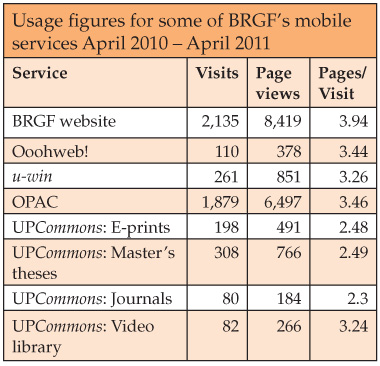
Table 1: Usage figures for BRGF mobile services
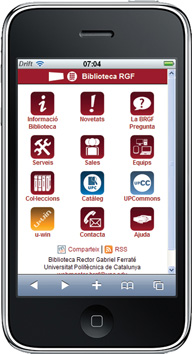
Figure 1: Mobile version of the BRGF homepage.
At present, approximately two years after the site was launched, the features available from BRGF’s mobile homepage (see Figure 1) can be grouped into:
-
Major sections also commonly found on the traditional websites of academic libraries: news, services, collections, information about the library, contact details and help.
-
Less common applications, some of which are nevertheless among the most popular in the mobile environment, such as information about room and equipment availability:
-
Equipment:
-
Availability of laptops for loan: The UPC libraries’ laptop-lending service has become one of its most popular services. Users can use the mobile website to check the availability of laptops at the library and to see when the next ones are scheduled to be returned. Moreover, if all laptops are currently checked out, users can use a link at the foot of the page to call the library directly from their mobile phone and add their name to a waiting list so as to be notified by text message as soon as the next one becomes available.
-
Availability of desktop computers in the library’s ClickArea, where the public desktop computers are located.
-
Availability of e-book readers, USB memory sticks, calculators and video-game consoles available on loan from the library.
-
-
Rooms: Information on the terms of use, availability and reservation of the group study rooms offered by the library.
-
La BRGFpregunta [BRGF wants to know]: Participation in the polls conducted by the library to determine users’ opinions on a specific topic at a given time. The polls are posted in a prominent position on the library’s website. Answers are not binding, but they are often used to help orient the services. Questions are usually closed-ended, although users can sometimes choose more than one answer (see Table 2).
-
-
Access to UPC’s open-access institutional repositories (UPCommons), the UPC library system’s mobile catalogue and the mobile version of u-win, BRGF’s video-game service area. All of these tools will be discussed in further detail below.
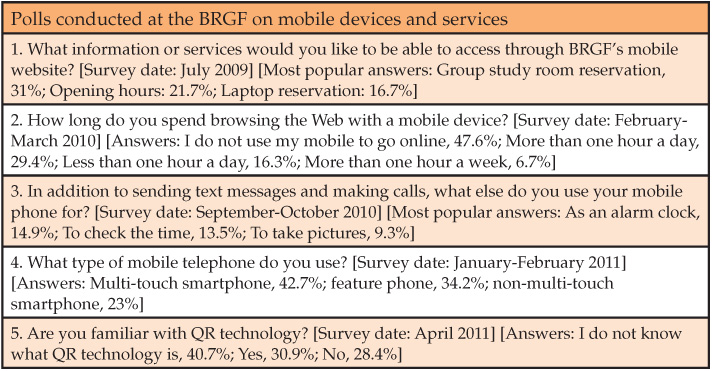
Table 2: Results of BRGF polls on mobile issues.
One of SBDUPC’s most important collections is UPCommons, a website containing the university’s main institutional repositories and offering open access to much of UPC’s scientific and academic output. The mobile version of the site offers access to all this material from mobile devices. It consists of a main website offering links to mobile versions of the main institutional repositories, as well as a search engine allowing users to search the material in those repositories. Access is currently available to the mobile versions of four UPC repositories:[10]
-
E-prints UPC [UPC E-prints]: Repository consisting of the scientific documents generated by the university’s faculty members and research community as a result of their research.
-
Treballsacadèmics UPC [UPC Academic papers]: Comprises a largeshare of the final degree papers and master’s theses written by UPC students.
-
Revistesicongressos UPC [UPC Journals and conferences]: Open access journals published by the university and materials from conferences held there.
-
Videoteca UPC [UPC Video library]: Repository of academic and institutional videos made at the university.
Each of these mobile websites has three sections:
-
Novetats [What’s new?]: The latest additions to the website (users have the option of subscribing to the website’s RSS feed).
-
Comunitats [Communities]: List of the communities and collections to which the materials belong.
-
Cercador [Search engine]: Tool for searching the repository in question. Searches can be performed by title, author, subject, date, abstract and URI (URL of the file with the material’s metadata).
These repositories, like the original ones, offer open access to full-text versions of all content under creative commons licences.
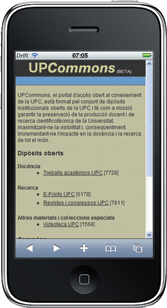
Figure 2: UPCommons mobile site.
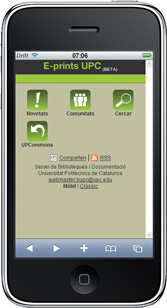
Figure 3: E-Prints UPC mobile site.
Like the other mobile websites, this one was developed by the library itself. However, it takes its data and materials from the UPCommons website, which is based on DSpace software. These data are imported daily to the mobile version through techniques such as screen scraping (to import communities and collections) or the OAI-PMH protocol (to import the material’s metadata), which all these UPC repositories have.
The objective of the mobile online public-access catalogue (OPAC) developed by BRGF and SBDUPC is to allow users to search the UPC library system’s catalogue from their mobile device under the same conditions as if they were using a computer.
The UPC library system’s catalogue uses Innovative Interface’s Millennium software (version 2009B1.2). This software optionally includes a module that makes it possible to create a mobile version of the catalogue. However, this module must be purchased separately from the subscription version and, after studying the costs, we decided to develop our own software for the mobile version of the UPC’s catalogue.
The full application consists of two modules:
-
Data mining: The full content of the Millennium catalogue is mined daily in XML format and, through internally developed software, uploaded into a MySQL database.
-
The website interface: Developed using the same programming language and technologies as were used for the mobile website, this module is basically run against the aforementioned MySQL database. It performs real-time Millennium OPAC queries to determine the status of each copy in the bibliographic records. This function is quite important, because the daily data mining does not provide this information.
Together these two elements — the data mining module and the website interface — allowed us to create our own mobile version of the UPC libraries’ OPAC, comprised of three main sections:
-
Cerca[Search], available in two modes: a simple search, consisting of a text field in which users can enter their search terms, and an advanced search, in which they can also specify the search field (title, author, etc.) and limit the search to a specific library. The results show the main fields of each record (title, author and publisher), as well as the available copies at each UPC library. Optionally, a specific icon can be used to access the full record of each document and to see all copies. This is useful for determining the exact location of each copy in a given record.
-
Biblios[Libraries]: This section allows users to view basic information about any UPC library, including its address, opening hours, calendar, a map and the telephone number.
-
Ajuda[Help]: Brief instruction manual on how to use the mobile catalogue and documentation regarding the meaning of the different icons and colours used on the website.
Thus, as with the query function in the traditional OPAC, the mobile catalogue can be used to access the UPC libraries’ subscription e-resources: in addition to individually catalogued e-books, the mobile OPAC enables access to e-journals, databases and reference e-books. Providers and publishers are also making a considerable effort to adapt their content to mobile devices and, at present, some of the key resources at UPC enabling convenient access from mobile devices include: IEEExplore, AIP/APS (the American Institute of Physics and the American Physical Society), ACS (American Chemical Society), Factiva, Emerald, Ebscohost, O’Reilly e-books, the journals Nature and Science, and the citation manager Refworks. Recently, UPC has also been working to offer content published with Edicions UPC in electronic format through the Iniciativa Digital Politècnica [UPC Digital Initiative] project.[12]
Subscription resources at UPC requiring authentication to be viewed can be accessed from mobile devices via a proxy server. Consequently, these resources can be accessed by any WiFi connection, including those that do not belong to the university itself.

Figure 4: UPC’s mobile OPAC.
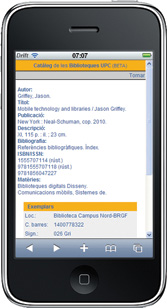
Figure 5: Bibliographic record on the mobile OPAC.
u-win is a service intended to broaden the library’s traditional portfolio by including gaming. BRGF believes in the educational power of video games and considers them to be tools with great potential, for both faculty and students. It moreover believes that these tools can pave the way to a more social use of the library, in which there is room for recreation in addition to the university campus’s traditional academic activities.
UPC offers postgraduate programmes and individual courses on video game development, in which students develop games as part of their coursework. u-win is used both to preserve and disseminate a selection of these games and to offer access to video games that were not developed at UPC, but which BRGF recommends.
Notwithstanding the above, besides a virtual platform, u-win is a physical space, located on the ground floor of BRGF and properly equipped. There, patrons can play some of today’s most popular games on a PC or Nintendo Wii in a laid-backsetting fitted out with comfortable furniture.
u-win’s offer is rounded out by two Nintendo DSi consoles, which can be checked out by users under the same conditions as the laptops.
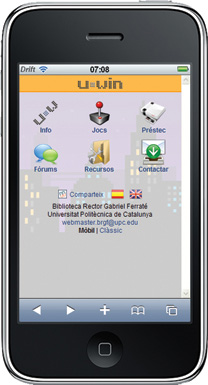
Figure 6: Mobile version of the u-win website.
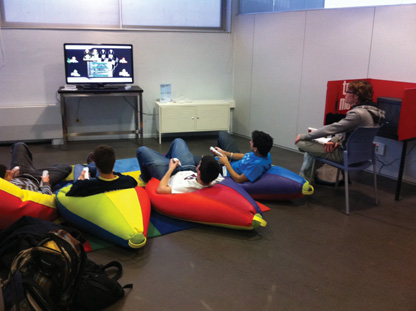
Figure 7: Physical u-win space.
BRGF has developed a mobile version of the u-win website offering the same features as the traditional version. However, the mobile version only includes games that have been adapted to mobile devices — in order not to frustrate its users.
u-win mòbil, the mobile version of the website, has the following sections:
-
Info [About]: Brief description of the website and the onsite service offered at BRGF.
-
Jocs [Games]: Access to a search engine to find games with a mobile version. Searches can be performed by title, type (free, UPC or commercial) and category (action, sport, strategy, skill, combat, platforms, puzzles and shooter simulator).
-
Préstec [Loan service]: Information on the console loan service, which includes two Nintendo DSi consoles and one room for playing a Nintendo Wii, in addition to the games themselves.
-
Fòrums [Forums]: Area for registered users to discuss video games, programming, etc.
-
Recursos [Resources]: Link to a selection of recommended reading, software and other online resources related to video game design and programming.
-
Contactar [Contact us]: This option allows users to send proposals for new games and resources to the library and submit any queries they may have to the library staff.
A Quick Response, or QR, code is a 2D image that can be used to store much more textual information than a traditional barcode. Initially, QR codes were created to manage factory stocks. However, over time, their use has become more and more oriented towards mobile phone users. The main advantage of a QR code is that, when a mobile phone with the necessary reader software installed is used to take a picture of it, the data it stores are automatically captured and transferred to the phone. There is thus no need to enter textual data manually using a mobile device’s keyboard or to write it down on paper.
Currently, QR codes are used at BRGF in the following ways:
-
On posters and signs to promote new services: The code contains the URL of the new website or service, primarily so that users do not have to remember it and can add it to their favourites or recommend it to others, but also occasionally to offer supplementary information about the website or service being announced.
-
For user registration in the ClickArea: The code contains the username and password needed to access the library’s computer classroom system. Thus, users do not need to keep track of any document with this information.
-
To process suggestions for improving services sent by users to the library’s institutional e-mail address using an adapted form.
-
To confirm the reservation of a group study room: The code contains the date and time of the reservation of the group study room made by the user. It thus helps users to remember the details of their reservations.
Because they are easy to implement, and given that users are increasingly familiar with them, as will be seen in the section on possible future mobile services at BRGF, the use of QR codes is expected to register a clearly upward trend in the library’s near future.

Figure 8: Sign with a QR code.
The UPC library system’s organisation chart has an unusual structure for a library service and is based on three operating units intended to meet the information and service needs of different user groups: the Learning Services Unit, the Research Services Unit and the Digital Services Unit.
Needless to say, technological development falls within the purview of the Digital Services Unit. In recent years, BRGF has tried to strengthen this unit in numerous ways:
-
Providing it with a manager exclusively responsible for digital activities.
-
Engaging a full-time computer engineer.
-
Collaborating closely with the ICT staff of SBDUPC’s General Services and with the staff of other libraries, as appropriate.
-
Exercising the option of taking on interns from the two schools on campus dedicated to ICT: FIB and ETSETB.
At the same time, a permanent task force has been set up to monitor and propose new technology applications, especially ones with a mobile component. This task force operates in parallel to the Digital Services Unit and is made up of people especially interested in such applications from all the library’s units. Above all, the task force members, like most of the library’s staff, subscribe to information sources on technology and libraries in order to stay abreast of the latest developments in the field.
From an organisational point of view, it was the measures taken to strengthen the Digital Services Unit, together with the involvement of people from other units and the interest in determining users’ opinions and keeping them satisfied by responding to their suggestions and comments, that allowed the library to develop the portfolio of technological services that has come to define it.
As for investment, in addition to the time and effort invested by the staff, it should be noted that the budget structure and budget management techniques of academic libraries do not tend to offer much leeway when it comes to investing money in these types of services, especially in software, which tends to be proprietary and to be priced beyond libraries’ means, or, at least, beyond the UPC libraries’ means.
Therefore, SBDUPC and BRGF have often chosen to:
-
work with open software.
-
develop in-house products with their own IT staff.
This policy has allowed us to create a range of products and services, the most significant example being the set of institutional repositories encompassed by UPCommons. While some of these products may not have as many features as others available on the market, they always allow us to set our own priorities in terms of what they need to offer users and, above all, they allow us to make our ideas a reality. To this end, all features of BRGF’s mobile services have been developed by members of the library and SBDUPC staffs, who have adapted features that had already been developed for non-mobile purposes or programmed new ones in order to allow us to provide a mobile service. We have thus been able to offer our users a suite of mobile services without spending a single euro beyond our regular staff costs.
Separately, it must also be borne in mind that making the library portfolio available on mobile devices, and, in general, wherever users may be, lends the libraries an image of ubiquity, service orientation and modernity that is invaluable at a time when libraries are so at risk of being stripped of their traditional role as intermediaries in the information environment. Users, especially students, must not be left with the notion of libraries as mere storage places for books, or libraries will definitively disappear from the world of information and digital services. We must invest as many resources and as much imagination as possible in the commitment to technology and in the identification of libraries as part of this commitment.
However, in an environment that includes many expert technology users, it is difficult to determine whether technology is a means or an end in itself in the effort to get users’ attention. BRGF strives to integrate the latest technology and available devices into what might be considered a more traditional library service. Thus, signs are enriched with QR codes, a space is fitted out to play video games, and a loan service is set up for e-readers, Nintendo DSs and iPads. There is always an underlying service or collection, or an educational or pedagogical rationale, to justify the use or acquisition of technology, but we also want the library to be seen as a media centre within the UPC’s North Campus, a show case for technology and an engine for the application of new technologies to everyday life. Undoubtedly, this will enhance the library’s reputation among users who arrive thinking that it is little more than a warehouse for books and is unlikely to have anything more to offer them. Perhaps users will be enticed to visit after hearing something about video games or tablets and will then fall into the dynamic of using BRGF’s other resources and services, too.
Although the products developed to date already cover the main features we had hoped to offer our users, BRGF and SBDUPC remain firmly committed to adapting new services to mobile devices. To this end, new objectives and future lines of action have been established, first, with a view to enhancing current products:
-
Enlarge the mobile version of the catalogue of UPC’s institutional repositories by incorporating other repositories, such as the Open Course Ware repository or the catalogue of UPC doctoral theses included in the TDX repository managed by the Consortium of Catalan University Libraries (CBUC).
-
Allow users to access their personal catalogue accounts (my catalogue) from the mobile catalogue so that they can take care of their personal business, view information on their loans, make renewals, etc.
-
Help to expand the mobile website model to include the other libraries in the UPC system.
-
Enable the mobile website to offer essentially customised services, including options such as allowing users to manage their group study room reservations or their login details for BRGF’s ClickArea, among others.
-
Improve the performance of all mobile websites, with special emphasis on search engines, and redesign certain interfaces to make them more user-friendly in order to make them quicker and more convenient for users to browse.
-
Allow videos from UPC’s video library to be played in real time on devices such as the iPhone or Android, along the lines of the YouTube model, so that users do not have to download an entire video onto their device in order to watch it.
-
Add covers and shelf maps (virtual shelves) to the mobile catalogue search results to make it easier for end users to find the documents they are looking for at UPC libraries.
-
Adapt the library’s themed websites — jazz, science fiction, Catalan poetry, and human and sustainable development — to the mobile version of the library’s site.
-
Increase the number of features that can be accessed through QR codes, enabling access to resources — identification of staff and functions at the BRGF, maps of the building’s different spaces and facilities, etc. — or enriched access to collections — sound and image archives, journal abstracts, specific information about documents in the OPAC, links to external websites, etc.
Second, efforts will be made to continue to work to develop new services and applications in this sphere. Some future possibilities include:
-
Expand the use of text message notifications, e.g. to include reminders of users’ room reservations, information on access to the library’s services or to let users know when a document they have requested through the Document Retrieval Service has arrived.
-
Implement a system of Bluetooth marketing campaigns aimed at further promoting the UPC libraries’ new mobile features and services.
-
Work on augmented reality projects that make it possible to find and enrich information on the spaces, equipment and documents available at the BRGF building.
-
Implement a chat function to allow users to submit real-time queries to the BRGF’s librarians.
-
Given the projected dramatic growth of tablets among UPC users, explore the possibility of adapting mobile interfaces to tablets, too.
-
Study the possibility and suitability of offering our own apps.
In short, BRGF plans to continue to engage in intense work in the sphere of mobile devices, conceiving of and creating new products and services and evaluating their future evolution so as to bring the UPC library system’s content and services closer to its users by means of their mobile devices.
Academic libraries have historically offered their services onsite, even when their portfolio was essentially technological. Equipment, facilities and the transformation thereof continue to be key to academic libraries’ success. However, with the rise of the Internet, remote access to services has been important for years, and today we are immersed in a new context, in which communication, service and commercial interactions are increasingly conducted with mobile devices — indeed, some of these interactions can only be conducted with such devices. In this environment, it seems not only appropriate but indeed critical to develop new channels aimed at providing mobile services. In the words of M.L. Jacobs (2009), ‘along with a new generation of technology, we have a new generation of users (…) [the] ING, the Information Now Generation. How better to describe a group of users that expects every thing at their fingertips regardless of where they are? And it is time for us to make and open mobile gates; there is no meeting someone half way to remain relevant’.
The Rector Gabriel Ferraté Library is located in a highly technological environment and considers its technological services to be its hallmark. Within this portfolio, BRGF has made mobile developments a clear priority in recent times and, through an organisation adapted to the strategic challenges facing the UPC Library and Documentation Service, has managed to develop a portfolio of mobile services that increase the means of accessing the library’s equipment and information resources. Sometimes, this has been done even knowing that the time was not yet ripe for a given service or device, that the technology or concept was still too new. For example, the decision to create BRGF’s mobile website was made at perhaps not the most opportune time, as Internet-enabled mobile devices had not yet taken root. Nevertheless, in light of current market trends, such devices — and, more specifically, smartphones with wide screens — were expected to become firmly entrenched and a part of users’ daily lives and, consequently, the decision was made to invest in the mobile website project despite the potential risks. Moreover, as noted above, the projected development cost was not too high, and the consensus was that, despite the risk, it was worth investing in implementing the new version of the website, which, in any case, could be considered a pilot test for assessing the acceptance and success of such products among the library’s users. The passage of time confirmed these predictions and today, nearly all users have an Internet-enabled mobile phone and the use of mobile services and applications is increasingly common, especially the use of those services shared by all UPC libraries. Consequently, the library has continued to develop new mobile projects, always for the purpose of bringing the library closer to users and facilitating and making more convenient their interaction with it. Furthermore, we plan to improve and expand these developments in the near future with a series of new features — explained above — that will simultaneously reinforce the idea of the library as a pioneer in the use of new technologies.
The UPC libraries consider being ahead of the curve to be a good strategy in general. At present, the commitment to mobile services is valued not so much in terms of the immediate use made of them — which, in any event, seems likely — as in terms of the positioning that such services imply. BRGF is convinced of the usefulness of this modus operandi and is keen to explore new possibilities to improve and expand the mobile offer in terms of access to content, additional and more customisable services, and its adaptation to the new devices that are constantly appearing on the market.
When it comes to mobile services, learning by doing is the UPC library system’s motto.
The authors wish to thank Ms Margarita CeñaCosials of the Andorra National Archive, for her collaboration and the information and ideas she provided throughout the writing of this paper.
|
American Library Association (2008): Games and gaming. Available at: http://connect.ala.org/gaming [Accessed: 04/05/2011].
|
|
Arroyo-Vázquez, N. (2009): ‘Web móvil y bibliotecas’, El Profesional de la información, 18(2), pp. 129–136.
|
|
Castells, M. … [et al.] (2007): Comunicación móvil y sociedad: una perspectiva global. 2ª ed. Barcelona: Ariel, Fundación Telefónica. 475 p. ISBN: 9788434453272.
|
|
Codina Vila, M., A. Pérez Galvez and J. Clavero Campos (2010): ‘Mobile services in the Rector Gabriel Ferraté Library, Technical
University of Catalonia’, Reference Services Review, 38(2), pp. 321–334.
|
|
Comisión del Mercado de las Telecomunicaciones (2010): Nota Mensual: Enero 2010. Available at: http://www.cmt.es/en/publicaciones/anexos/100308_NM_enero010.pdf [Accessed: 04/05/2011].
|
|
Davidson, M. (2005): Make your site mobile-friendly in two minutes. Available at: www.mikeindustries.com/blog/archive/2005/07/make-your-site-mobile-friendly [Accessed: 04/05/2011].
|
|
Federación de Gremios de Editores de España (2010): Informe Barómetro de Hábitos de Lectura y Compra de Libros en 2010. Available at: http://www.federacioneditores.org/0_Resources/Documentos/NP_Lectura2010_V3.pdf [Accessed: 04/05/2011].
|
|
Fundación Teléfonica (2010): La Sociedad de la información en España 2010. [S.l.]: Ariel, Fundación Telefónica. Available at: http://e-libros.fundacion.telefonica.com/sie10/ [Accessed: 04/05/2011].
|
|
Hanson, C.W. (2011): Libraries and Mobile Services. Chicago, IL: American Library Association. 34 p. Library Technology Reports, 47(2). ISBN 978-0-8389-5830-8.
|
|
Hassan, Y.; F.J. Martín Fernández and G. Iazza (2004): ‘Diseño Web centrado en el usuario: usabilidad y arquitectura de la
información’. Hipertext. net. No. 2. Available at: http://www.hipertext.net/web/pag206.htm [Accessed: 04/05/2011].
|
|
Huwe, T.K. (2009): ‘Thin client, meet the mobile future’, Computers in Libraries, 29(5), pp. 22–24.
|
|
Instituto Nacional de Estadística (2010): Cifras de población referidas al 01/01/2010 Real Decreto 1612/2010, de 7 de diciembre. Available at: http://www.ine.es/jaxi/menu.do?type=pcaxis&path=%2Ft20%2Fe260%2Fa2010%2F&file=pcaxis&n=&L=0 [Accessed: 04/05/2011].
|
|
Jacobs, M.L. (2009): ‘Libraries and the mobile revolution: remediation=relevance’, Reference Services Review, 37(7), pp. 286–290.
|
|
Johnson, S. (2005): Everything bad is good for you: how popular culture is making us smarter. New York: Penguin Books. 238 p. ISBN: 9780141018683.
|
|
Kolb, L. (2008): Toys to Tools: Connecting Student Cell Phones to Education. Eugene, OR: International Society for Technology in Education. 230 p. ISBN 9781564842473.
|
|
Kroski, E. (2008): ‘On the move with the mobile web: libraries and mobile technologies’. Chicago, IL: American Library Association. 48 p. Library Technology Reports, 44(5). ISBN 978-0-8389-5795-0. Available at: http://eprints.rclis.org/bitstream/10760/12463/1/mobile_web_ltr.pdf/ [Accessed: 04/05/2011].
|
|
Liston, S. (2009): ‘OPACs and the mobile revolution’, Computers in Libraries, 29(5), pp. 6–8, 10–11, 42–47.
|
|
McGonigal, J. (2011): Reality is broken: why games make us better and how they can change the world. New York: Penguin. 388 p. ISBN: 9781594202858.
|
|
McKiernan, G. (2009): Mobile libraries. Available at: http://mobile-libraries.blogspot.com/ [Accessed: 04/05/2011].
|
|
Midwestern Mac, LLC (2009): Adapting your web site for the iPhone. Available at: www.midwesternmac.com/tutorial/2009-01-13/adapting-your-Website-iphone [Accessed: 04/05/2011].
|
|
Ofcom (2009): Digital Lifestyles: Young adults aged 16-24. Available at:
http://stakeholders.ofcom.org.uk/binaries/research/media-literacy/young_digital_lifestyles.pdf [Accessed: 04/05/2011].
|
|
Ofcom (2011): The Communications Market 2010 (August). Available at: http://stakeholders.ofcom.org.uk/market-data-research/market-data/communications-market-reports/cmr10/uk/ [Accessed: 04/05/2011].
|
|
Ruadhan (2008): Lightweight device-detection in ASP. Available at: http://mobiforge.com/developing/story/lightweight-device-detection-asp [Accessed: 04/05/2011].
|
|
Seeholzer, J. and J.A. Salem (2010): ‘Library on the Go: A Focus Group Study of the Mobile Web and the Academic Library’, College and Research Libraries, 27(19–20), pp. 9–20.
|
|
Serrano-Muñoz, J. (2000): Acceso a la Biblioteca de la UOC por medio de la telefonía móvil. Available at: http://biblioteca.uoc.edu/cgi-bin/pass/byteserver.pl/docs_elec/ponencies/3538.pdf [Accessed: 04/05/2011].
|
|
The Nielsen Company (2010): Mobile Youth Around the World: December 2010. Available at: http://www.nielsen.com/content/dam/corporate/us/en/reports-downloads/2010%20Reports/Nielsen-Mobile-Youth-Around-The-World-Dec-2010.pdf [Accessed: 04/05/2011].
|
|
Biblioteca Rector Gabriel Ferraté. < http://bibliotecnica.upc.edu/BRGF/>. [Accessed: 04/05/2011.] |
|
|
UPC. < http://www.upc.edu/>. [Accessed: 04/05/2011.] |
|
|
Bibliotècnica. < http://bibliotecnica.upc.edu>. [Accessed: 04/05/2011.] |
|
|
FIB. < http://www.fib.upc.edu/fib/>. [Accessed: 04/05/2011.] |
|
|
ETSETB-Telecom BCN. < http://www.etsetb.upc.edu>. [Accessed: 04/05/2011.] |
|
|
ETSECCPB. < http://www-camins.upc.es/>. [Accessed: 04/05/2011.] |
|
|
For further information on the decision-making involved in this issue, C.W. Hanson (2011) offers other reasons for reaching the same conclusion. |
|
|
Biblioteca Rector Gabriel Ferraté mòbil. < http://bibliotecnica.upc.edu/BRGF/m/>. [Accessed: 04/05/2011.] |
|
|
UPCommons. < http://m.upcommons.upc.edu/>. [Accessed: 04/05/2011.] |
|
|
UPCommons is essentially comprised of the following repositories: Videoteca [Video library], Materials docents UPC — UPCOpenCourseware [UPC Teaching materials/UPCOpenCourseWare], Treballsacadèmics [Academic papers], E-prints and Revistesicongressos [Journals and conferences]. Of these repositories, only Materials docents UPC has yet to be converted to a mobile format. SBDUPC’s other main repository is Tesisdoctorals [Doctoral theses]. This repository is not hosted on internal servers, but rather on those of the Consortium of Catalan University Libraries (CBUC). |
|
|
Catàleg de les Biblioteques UPC (mòbil BETA) UPC. < http://m.cataleg.upc.edu>. [Accessed: 04/05/2011.] |
|
|
Iniciativa Digital Politècnica – Universitat Politècnica de Catalunya (UPC-Barcelona Tech). < http://www.upc.edu/idp>. [Accessed: 04/05/2011.] |
|
|
Biblioteca Rector Gabriel Ferraté — u-win. < http://flas.upc.edu/uwin/m/catala/home/home.php>. [Accessed: 04/05/2011.] |
|
|
Biblioteca Rector Gabriel Ferraté — Codis QR. < http://bibliotecnica.upc.edu/BRGF/serveis/qr>. [Accessed: 04/05/2011.] |